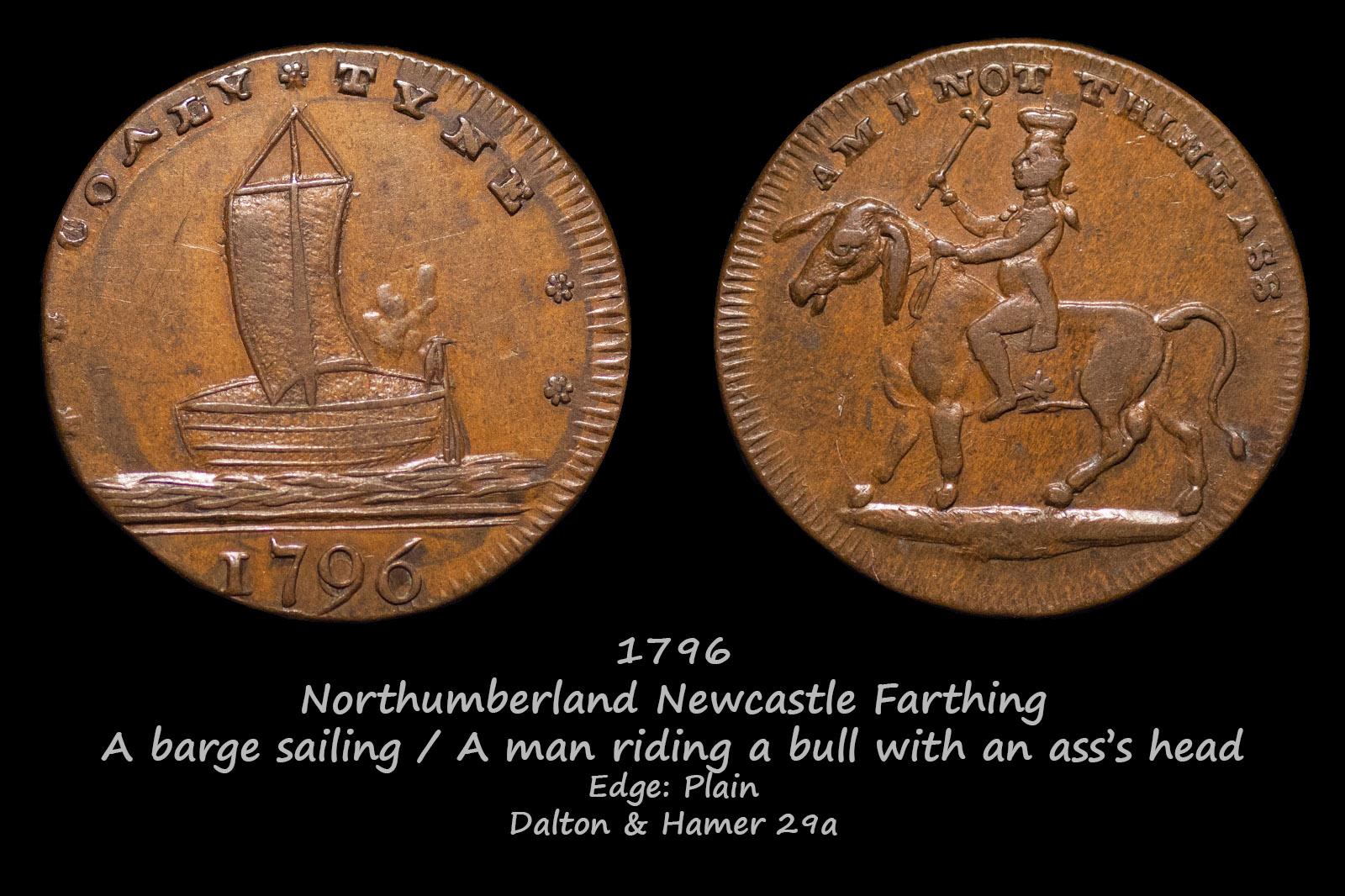
Online collections
monedastodas.com
All collections » Tokens » Newcastle Farthing
The obverse shows a barge (or "keel" - a word derived from the Anglo-Saxon type of boats known as "ceol", which means "boat") under sail, carrying coal on the River Tyne. Above is the circular inscription " Coaly Tyne" (Coal Tyne).

The keel was built of wood and had an almost oval shape with a flat bottom. The people working on these barges were called keelmen. The first mention of kilmen dates back to 1516; in 1539 their own brotherhood was registered, located in the immediate vicinity of the wall of the old city of Newcastle.
 Newcastle-upon-Tyne
from New Chatham engraving by William Miller after Thomas Allom, published in
Westmoreland, Cumberland, Durham & Northumberland. Illustrated from
original drawings by Thomas Allom etc. With historical &
topographical descriptions by Thomas Rose. Fisher Son and Co.,
London 1832
Newcastle-upon-Tyne
from New Chatham engraving by William Miller after Thomas Allom, published in
Westmoreland, Cumberland, Durham & Northumberland. Illustrated from
original drawings by Thomas Allom etc. With historical &
topographical descriptions by Thomas Rose. Fisher Son and Co.,
London 1832Kilmen lived in Sandgate - one of the poorest and most densely populated areas of Newcastle, consisting of many narrow streets. Kilmen wore a distinctive costume consisting of a blue jacket, yellow waistcoat, flared trousers, and a blue cap. Due to the shallow depth of the River Tyne, sailing ships did not reach the port of Newcastle for about 10 miles, and the task of the keelmen was to transport coal from coal mines to the harbor at North Shields, from where large sailing ships delivered cargo to the east coast of London. Up to 20 tons of coal fit in one barge and transportation was carried out in any weather, day and night.
 Keelmen
Heaving in Coals by Moonlight, 1835, Joseph Mallord William Turner (1775–1851)
Keelmen
Heaving in Coals by Moonlight, 1835, Joseph Mallord William Turner (1775–1851)At low tide, the barges moved downstream with the help of oars, and after unloading, at high tide, they returned back to Newcastle; with a fair wind, a sail was set. The crew of the barge consisted of a skipper, two crew members and an apprentice boy, known as Pee Dee, because jobs were usually passed down from father to son.
The reverse side depicts a king with a
scepter in his hand and huge spurs, riding a bull with a donkey's head. Circle
legend: “AM I
NOT THINE ASS?” (Am
I your donkey?).
The phrase of the circular legend is from
the Old Testament, chapter 22, verse 30: “And
the ass said unto Balaam, Am
I not thine ass upon
which thou hast ridden ever since I was thine unto this day? Was I
ever accustomed to do so unto thee? And he said, No" . (The
donkey said to Balaam: Am I not your donkey, on which you rode from the
beginning to this day? Have I been in the habit of doing this to you? He said:
no).
 Balaam
and the Angel, illustration from the 1493 Nuremberg Chronicle
Balaam
and the Angel, illustration from the 1493 Nuremberg ChronicleThe image of a bull with a donkey's head, borrowed from the biblical scene with Balaam's donkey, personifies John Bull, a poor stupid donkey, representing the British public trampled on by the monarchy. The expression John Bull was widely used in accusatory pamphlets and newspapers of the time as a nickname for the typical average Englishman:
“John once was deem'd JOHN BULL; but
now, alas;
His spirit gone, he's mildly nam'd
JACK ASS”
Once called John the Bull; but,
unfortunately,
he was weakened in spirit and now, his
name is Donkey.
 The
Prophet Balaam and the Ass, 1622, Pieter Lastman (1583 - 1633)
The
Prophet Balaam and the Ass, 1622, Pieter Lastman (1583 - 1633)  Balaam
and the Ass, 1626, painting by Rembrandt (1606 - 1669)
Balaam
and the Ass, 1626, painting by Rembrandt (1606 - 1669)